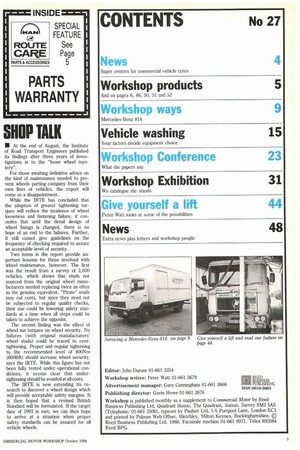SHOP TALK
Page 41

If you've noticed an error in this article please click here to report it so we can fix it.
• At the end of August, the Institute of Road Transport Engineers published its findings after three years of investigations in to the "loose wheel mystery".
For those awaiting definitive advice on the kind of maintenance needed to pre vent wheels parting company from their own fleet of vehicles, the report will come as a disappointment.
While the IRTE has concluded that the adoption of greater tightening tor ques will reduce the incidence of wheel looseness and fastening failure, it concedes that until the detail design of wheel fixings is changed, there is no hope of an end to the failures. Further, it still cannot give guidelines on the frequency of checking required to assure an acceptable level of security.
Two items in the report provide important lessons for those involved with wheel maintenance, however. The first was the result from a survey of 2,800 vehicles, which shows that studs not sourced from the original wheel manu facturers needed replacing twice as often as the genuine equivalent. "Pirate" studs may cut costs, but since they need not be subjected to regular quality checks, their use could be lowering safety standards at a time when all steps could be taken to achieve the opposite.
The second finding was the effect of wheel nut torques on wheel security. No failures (with original manufacturers' wheel studs) could be traced to overtightening. Proper and regular tightening to the recommended level of 800Nm (600Ibft) should increase wheel security, says the IRTE. While this figure has not been fully tested under operational conditions, it seems clear that undertightening should be avoided at all costs.
The IRTE is now extending its research to discover a wheel design which will provide acceptable safety margins. It is then hoped that a revised British Standard will be formulated, If the target date of 1991 is met, we can then hope to arrive at a situation when proper safety standards can be assured for all vehicle wheels.










































































